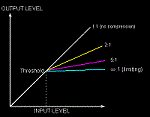This is the wiki for products made by Fractal Audio Systems, maintained by members of the community.
November 2025: the wiki is updated with AM4 data.
Difference between revisions of "Compressor block"
| Line 31: | Line 31: | ||
The AMP block has built-in compression: Dynamics parameter in the preamp section, and OUT COMP at the output. You can use it instead of a separate Compressor block. It increases CPU usage. | The AMP block has built-in compression: Dynamics parameter in the preamp section, and OUT COMP at the output. You can use it instead of a separate Compressor block. It increases CPU usage. | ||
| − | Fractal Audio: | + | Fractal Audio:<BR> |
"The Dynamics knob in the Amp block does the same thing as the Dynamics mode of the compressors so you can save a block that way." [http://forum.fractalaudio.com/threads/comp-vs-multicomp.107343/#post-1284495 source] | "The Dynamics knob in the Amp block does the same thing as the Dynamics mode of the compressors so you can save a block that way." [http://forum.fractalaudio.com/threads/comp-vs-multicomp.107343/#post-1284495 source] | ||
Revision as of 11:40, 15 April 2017
The information on this page supplements the official manuals.
Contents
- 1 Compressor/Dynamics: supported by which Fractal Audio products?
- 2 X/Y switching in the Compressor/Dynamics block
- 3 About the Compressor/Dynamics types
- 4 Compressor block or Amp block compression
- 5 Position of Compressor/Dynamics block on the grid
- 6 Mix parameter
- 7 Sidechain Select parameter
- 8 Release parameter (Pedal mode)
- 9 Emphasis parameter
- 10 Lookahead parameter
- 11 Fast RMS detector
- 12 Using Compressor as a limiter
- 13 More information

Compressor/Dynamics: supported by which Fractal Audio products?
- Axe-Fx II: yes.
- FX8: yes.
- AX8: yes.
X/Y switching in the Compressor/Dynamics block
The Compressor block in the Axe-Fx II XL, XL+, FX8 and AX8 supports X/Y switching.
There's no MIDI CC available for X/Y switching in the Axe-Fx II XL/XL+.
About the Compressor/Dynamics types
The "Pedal 2" type uses a different algorithm (than "Pedal 1") which is smoother and pumps less.
CPU usage by both "Pedal" types is much less than the "Studio" type.
The Dynamics algorithm allows compression or expansion with a single control. When the Dynamics parameter is set to negative values the block compresses the signal, when set to positive values the block expands the signal.
Quantum 7 added two “Optical” types to Compressor block. Optical 1 is based on classic optical tube compressors famed for their smooth sound. Use before the Amp block to smooth out your licks and increase sustain. Use after the Amp block for instant “Hit Record” sound. Optical 2 is similar to Optical 1 but uses a true RMS detector.
Fractal Audio:
- "Optical 1 uses a full-wave rectifier as a detector (peak detector). Optical 2 uses a true RMS detector. The LA-2A and many other compressors use rectifiers as detectors because it's easy and simple. Technically true-RMS detectors are "better" but they are difficult to implement in analog hardware. Whether or not true-RMS is better in actual real-world applications is debatable. There are those that claim that true-RMS detectors more closely replicate the natural compression behavior of the human auditory system. Peak detectors respond more rapidly to transients while RMS detectors have a smoother behavior. The only way to know which you like better is to try them." source
- "It's not an "LA-2A" but it can sound like one. It's a generic optical compressor that can be adjusted to sound like a variety of compressors. It has adjustable attack, release and compression." source
- "The LA-2A, CL1B, et. al. are high-end studio compressors that use optical circuits." source
Compressor block or Amp block compression
The AMP block has built-in compression: Dynamics parameter in the preamp section, and OUT COMP at the output. You can use it instead of a separate Compressor block. It increases CPU usage.
Fractal Audio:
"The Dynamics knob in the Amp block does the same thing as the Dynamics mode of the compressors so you can save a block that way." source
Position of Compressor/Dynamics block on the grid
Placing the Compressor block after the Amp block makes it interfere less with the amp dynamics.
When placing a Pedal- or Optical-type compressor after the Amp block, set its input to Line (instead of Instrument).
Mix parameter
Compressors are used mostly as a 100% wet effect. But there are compressors with Blend or Mix controls. These can be simulated by using the Mix parameter.
Sidechain Select parameter
You can use the signal that enters the grid to feed the compressor, even if the compressor block is placed further upon the grid, through the Sidechain Select parameter (Studio mode only).
Release parameter (Pedal mode)
Fractal Audio:
- "Pedal compressors typically have very long release times so the time is scaled by 10 for pedal mode. The time in studio mode is accurate to within a microsecond." source
- "The times are the classic "time constants" for analog circuits, i.e. the time it takes for a signal to settle to 37% of it's final value (e^-1)." source
Emphasis parameter
Since the Pedal mode does not have a side-chain, this allows for a similar function by pre-emphasizing the high frequencies prior to compression and then de-emphasizing them after.
Lookahead parameter
The default Lookahead value has been changed to 0 in firmware 16.x, because of detector improvements.
Fast RMS detector
The “Fast RMS” Detector type in the Studio Comp mimics the fast detectors in classic rack-mount compressors. It uses less CPU than the other detectors.
Using Compressor as a limiter
There's no dedicated brickwall limiter in the unit, but the compressor can be used as such. From the manual: "Setting the RATIO to “INFINITY” turns the compressor into a “limiter,” reducing any level above the threshold to the threshold, applying a sort of “ceiling” or “brick-wall limiting” above which nothing can rise." More information.